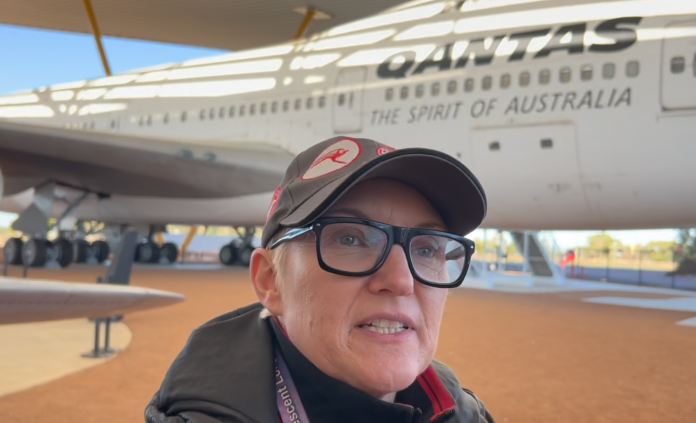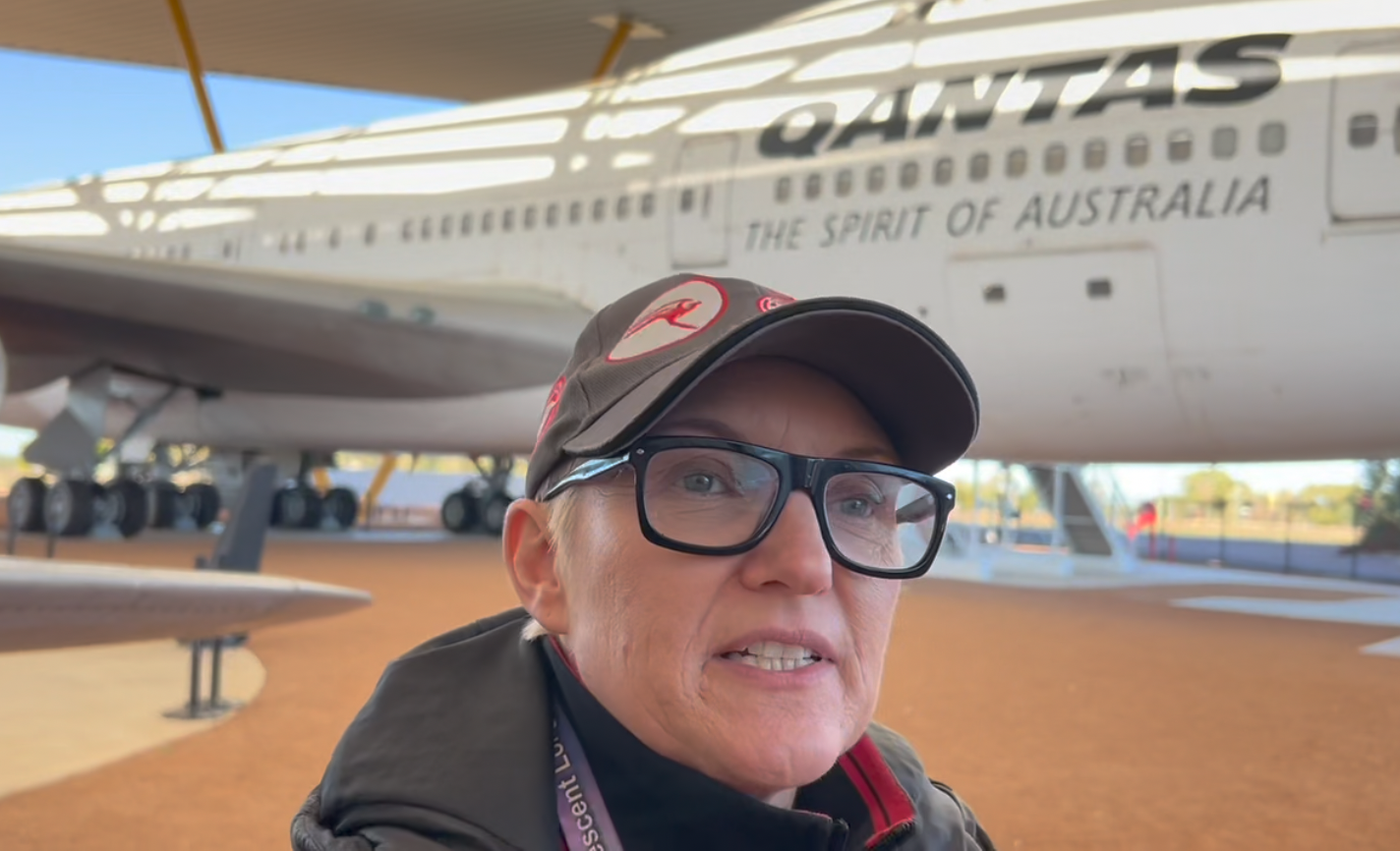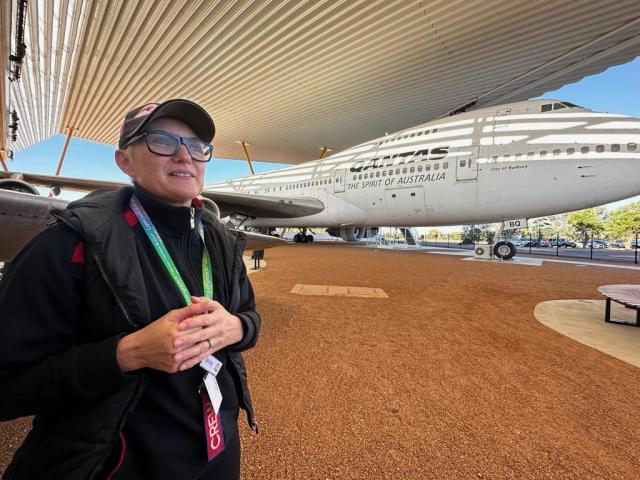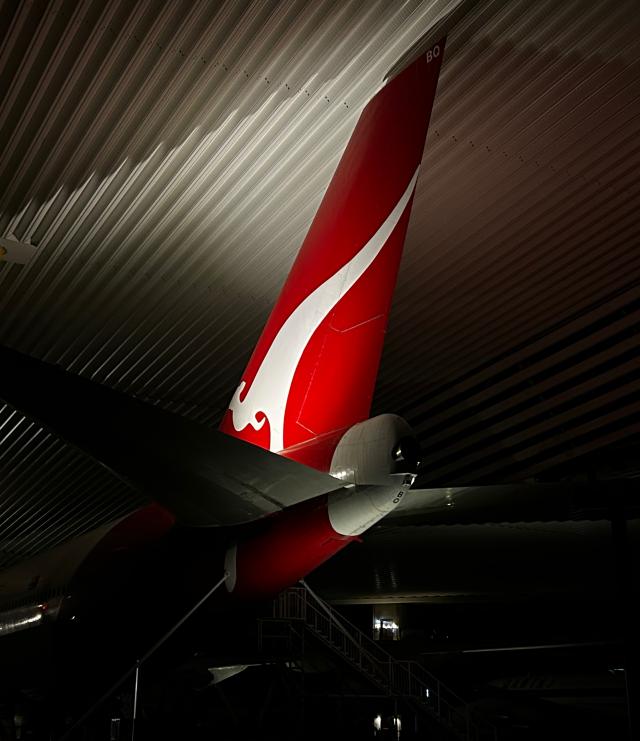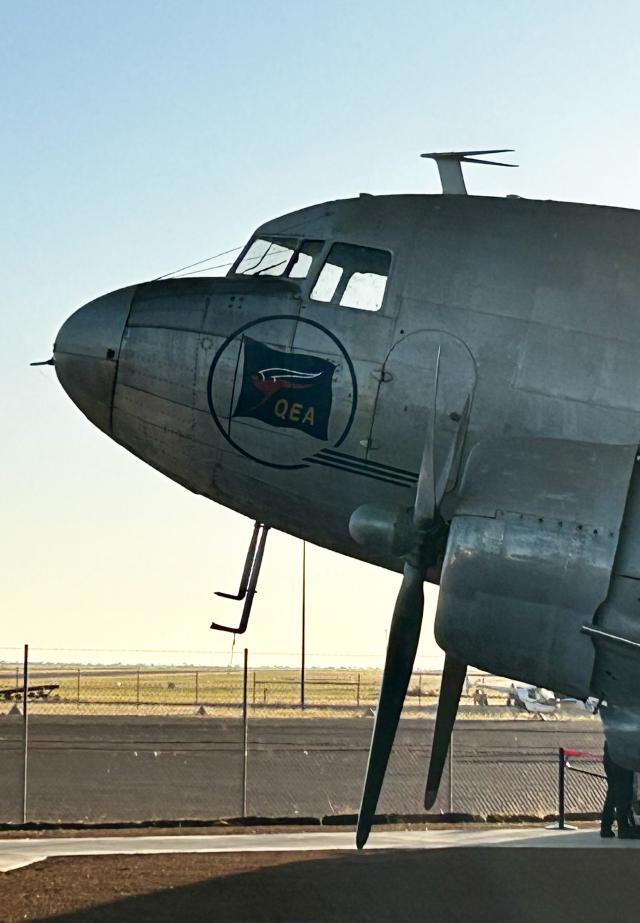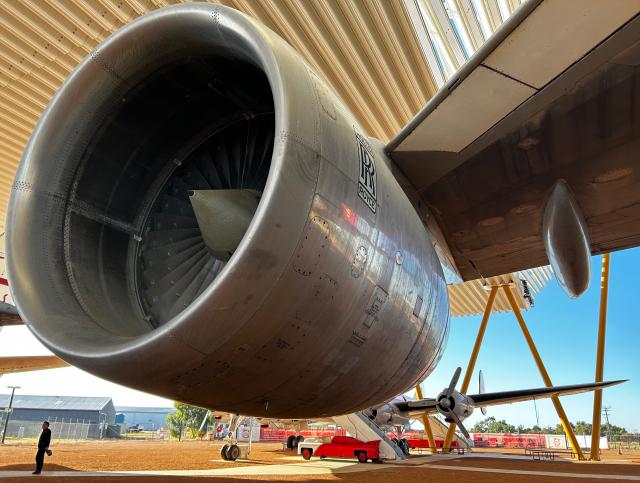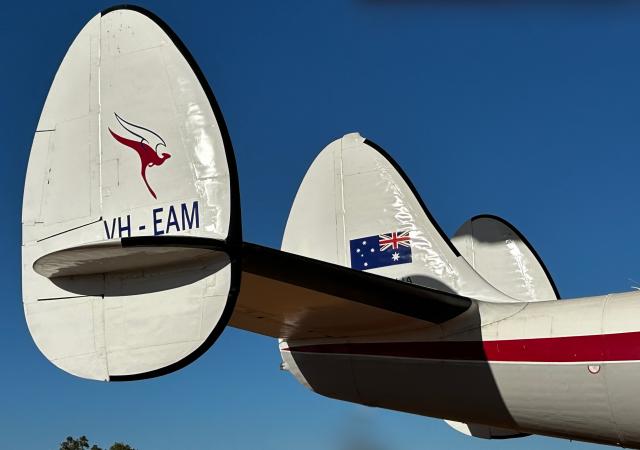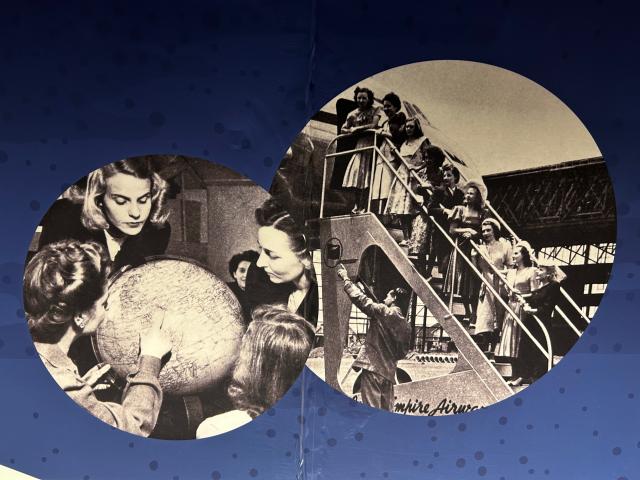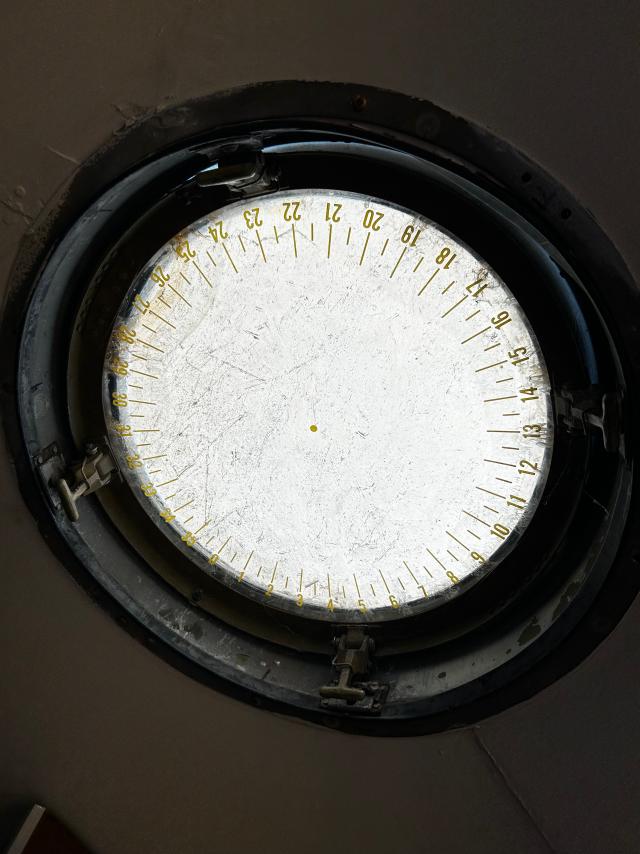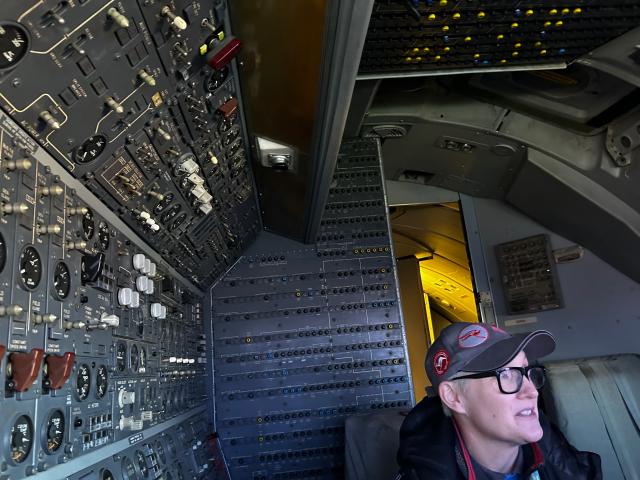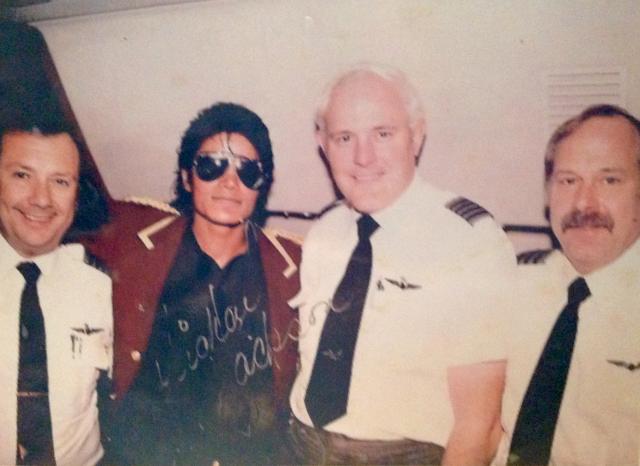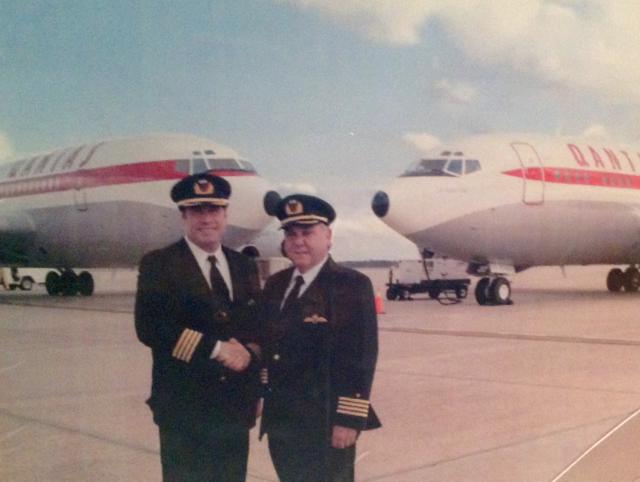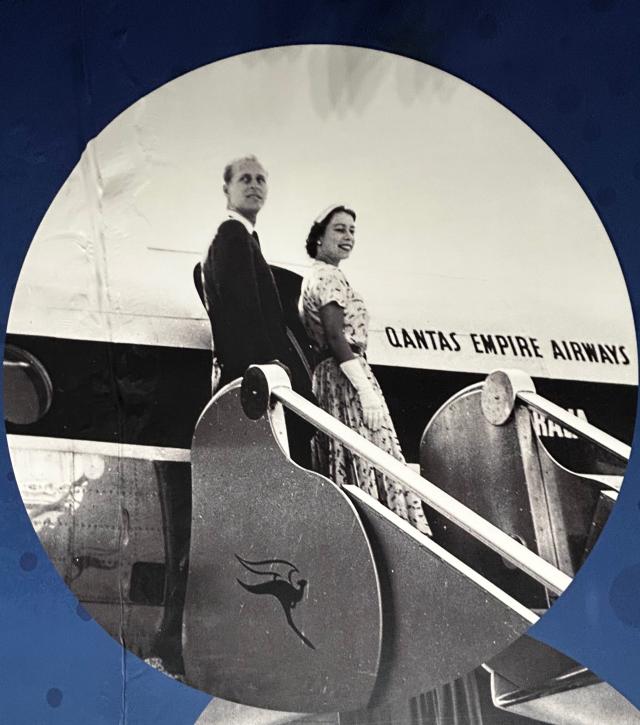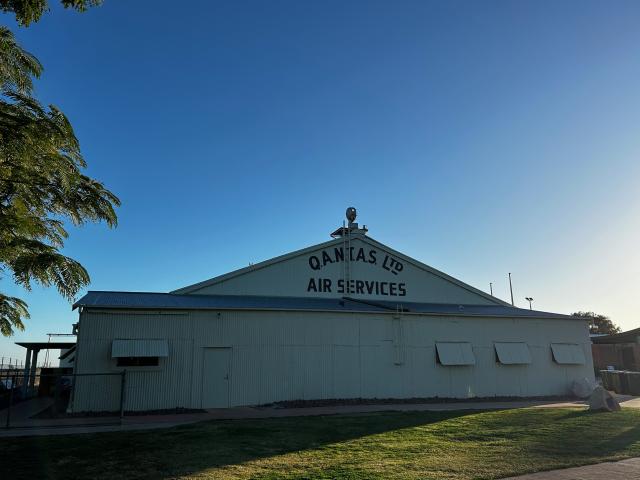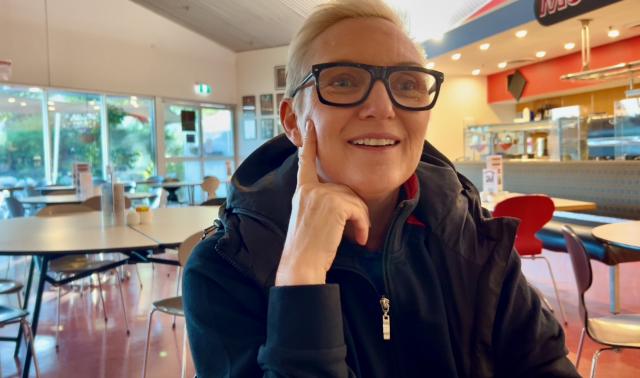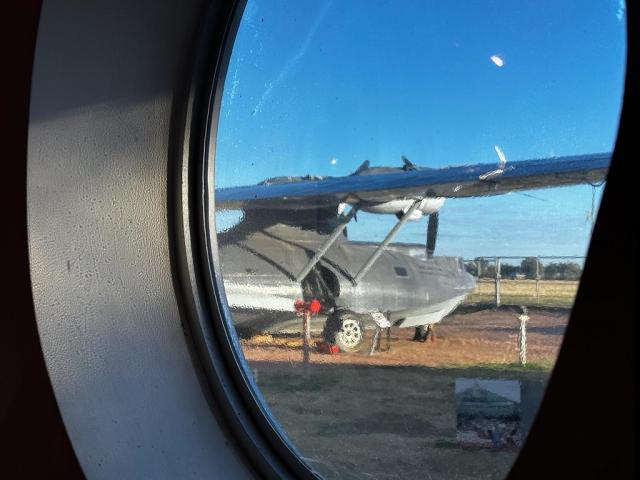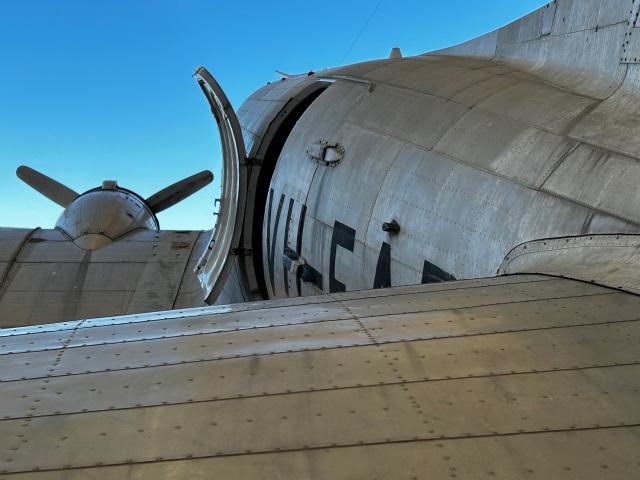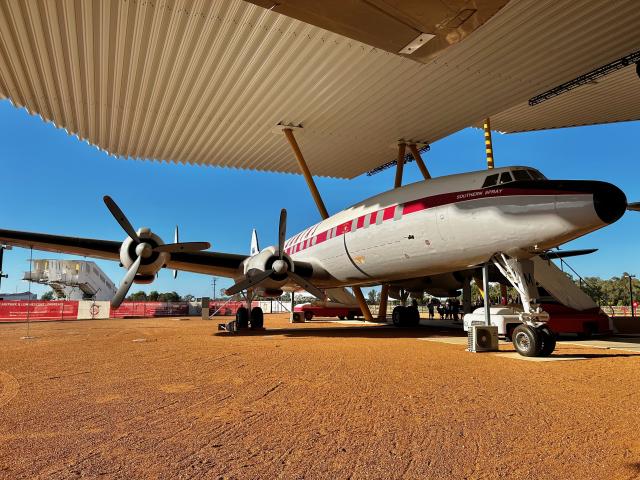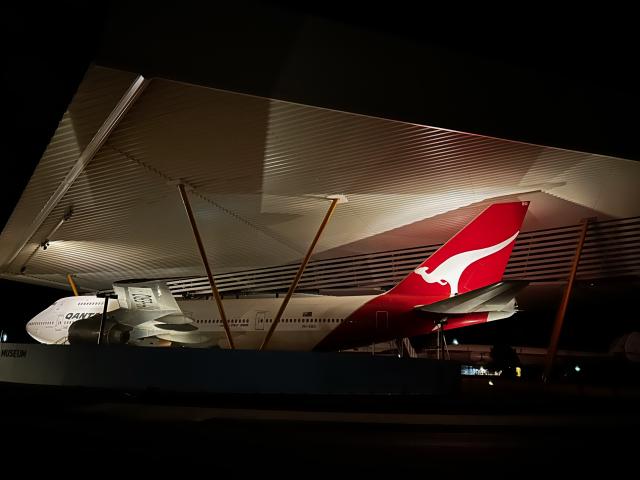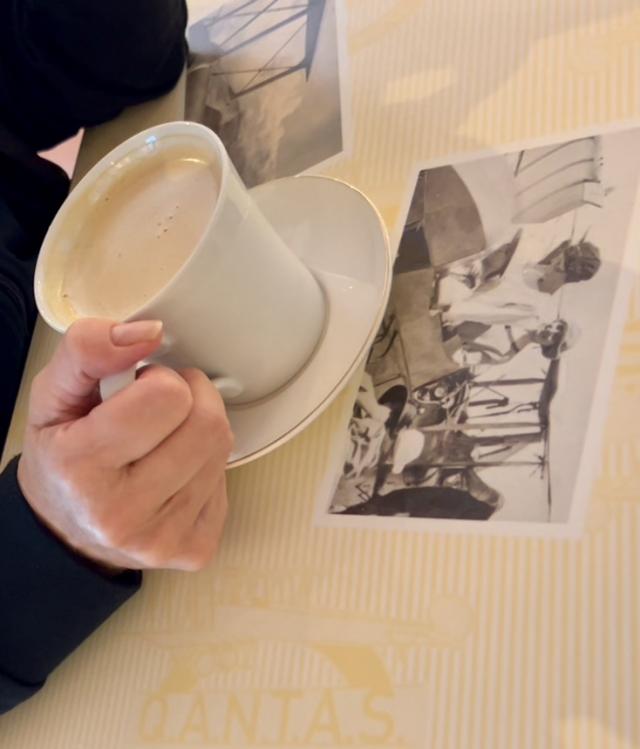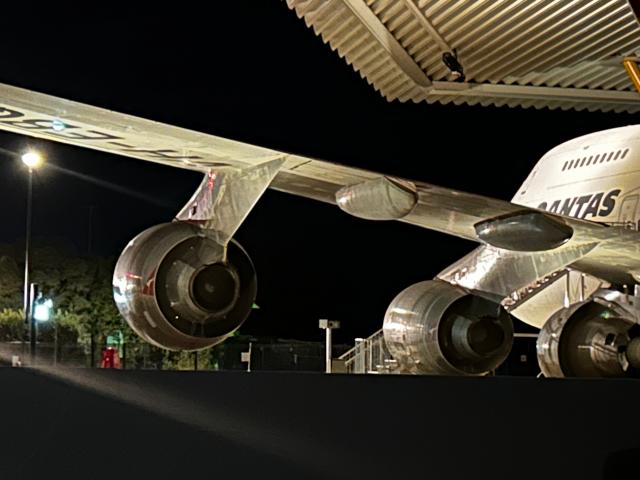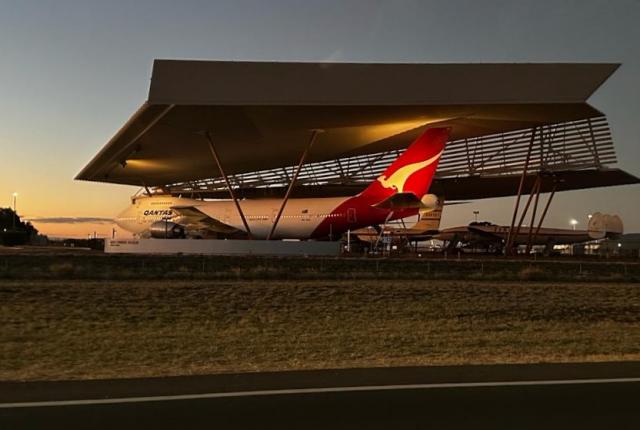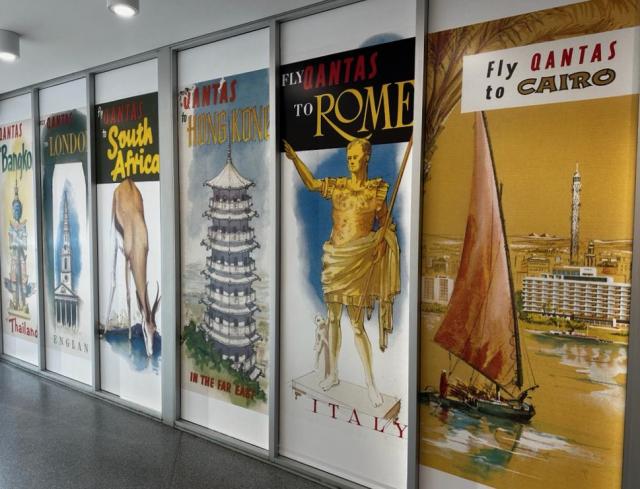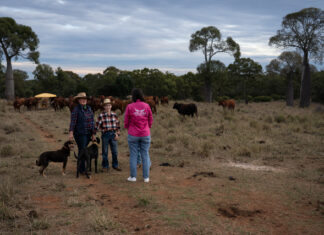PRECEDE
Australia’s national airline may have been experiencing turbulence in the board room of late but ERLE LEVEY meets someone with her head in the sky and her feet firmly on the ground.
BREAKOUT QUOTE
“With my grandfather flying in the war I have a sort of family affinity with Qantas. He survived 95 sorties and got a Distinguished Flying Cross (DFC).“
What happened in the air, shaped Australia on the ground.
And what happened at Longreach determined how, as a nation, we opened up the skies.
It was here that the story of Qantas was born … an outback air service between Longreach and Darwin that grew to cover the world.
Qantas was instrumental in opening up inland Australia. In doing so it built a reputation on service and one of safety that is unequalled around the globe.
The airline flies to all seven continents, including Antarctica.
Its history as one of the first airlines stretches back more than 100 years, second only to the Dutch national carrier KLM.
The Qantas Founders Museum at Longreach provides an extraordinary link spanning that time … from flimsy timber-framed biplanes and a tin shed used as a hangar to the architect-designed Airpark that includes aeroplanes covering that same distance in time – a Douglas DC3, Lockheed Super Constellation, Boeing 707 and Boeing 747. In another section is a Catalina flying boat.
It was here that we met Sarah Johnson, senior curator of the museum, whose life story is almost as fascinating as that of the airline.
Qantas was born out of World War I.
In November 1920, Australian Flying Corps veterans Paul McGinness and Hudson Fysh envisaged an air service connecting Australia to the world.
In conjunction with Fergus McMaster, Queensland and Northern Territory Aerial Services Ltd was established.
A year earlier Fysh and McGinnis had set out from Longreach in a T-model Ford to establish a route to Darwin. There were no roads, no maps of any worth, but 51 days later they arrived at Katherine and were convinced Australia needed planes to cover this broad expanse.
This journey started Qantas and eventually the Royal Flying Doctor Service.
While Winton is recognised as the birthplace of Qantas, it was decided that Longreach should be the centre of operations and an early office still stands in the town today.
Our journey started at sunrise. Standing at the museum with the first light of day reflecting on the series of planes on display that have made the service famous around the world.
There is a sound like planes coming into the nearby airport, but they’re not there. It’s a mystery.
Then you realise the huge cantilever shelter over the planes in the Airpark – a contextual masterpiece in its on right – is actually a reflector or a collector of sound from the passing road trains.
Either deliberately or by happen-chance it resembles the sound of jet planes. It’s just as if you are on a mystery flight. That’s the introduction we had this time.
The tail of the Boeing 747 stands three-storeys above the surrounding plains. A landmark when you enter the town.
It’s a clear morning and soon we are sharing a coffee with Sarah Johnson in the museum restaurant.
Sarah admits to having had a mixed bag of careers but visual art is a real passion.
The Powerhouse, Newcastle Museum, and the National Maritime Museum at Darling Harbour in Sydney are all part of her resume.
Sarah also worked for the Sydney Harbour Bridge climb during the Sydney 2000 Olympics.
“I look after the collection here,’’ she admits.
“It’s a pretty responsible position … a custodian of everything , from the postage stamps to a 747 and everything in between.’’
The aeroplane collection, spanning the 100 years or so of Qantas, provides some big wall hangings, not just a rack of paintings to pull out as you would at an art gallery.
Indeed, one of the big stories last year was doing a complete stocktake of the collection, Sarah said.
“You cannot run a collection unless you know everything that you’ve got here.
“The Founders Museum is more than 20 years old, so we are looking to freshen things up.
“It’s a non-for profit organisation so we really do need to rely on people through the door as well as financial support.
“Tony Callinan is the CEO of Founders and we are looking to future-proof the organisation.’’
Sarah has worked in government before so understands the structures that help financially.
“Even though we’re not part of Qantas, we have a relationship with them.
“Qantas people are on the board – it’s a great working relationship.’’
The story of Qantas is as much about people as it is about innovation.
Looking through the history on display you can just imagine the impact it would have on those who have been in the air industry or the armed forces.
Pilots, the cabin crew, flight engineers, navigators, maintenance people … and that they would get this nostalgic far-away look in their eyes.
As we walk across to the Airpark with Sarah to see the aeroplanes on show, you reflect on how this was one of those moments in your life where you wonder: How did I get here? How was I fortunate enough to fall into this experience?
What you also come to realise is how passionate, genuine, interested and intelligent Sarah. It’s as if she was born for this role.
Not only incredibly knowledgeable, she is more than that; there is a family history and connection with Australia and Qantas.
Sarah’s history goes goes back to World War II when her grandfather flew Lancaster bombers in what they call the Pathfinders – flying across Europe into Germany.
The life expectancy for bomber crews was very short, with fledgling crews often being lost during their first 12 operations and an “operational tour“ usually of about 30 missions.
Her grandfather flew more than 90 … and survived.
So Sarah’s passion drove our conversation with her – through history to the current time where she is undertaking some remarkable work for the museum to ensure its longevity for generations to come.
She showed us through each of the aircraft on display and, honestly, it was the most phenomenal, insightful, fascinating journey through aviation history.
We thought we knew the airline and its history well but this experience took your insight and knowledge to another level.
I had no idea how opulent some of the flight experiences were for those better-off in society.
The plane that I was most taken by was the one where the entire furnishings were teak.
It was a Boeing 707 and there are photographs of the layout. It’s really quite incredible how these planes were fitted out.
Yes, there were only 12 in the Qantas fleet and this particular aircraft was number one.
Apparently John Travolta has his own private 707 in Qantas colours and is numbered 13.
There is a photo of him meeting the captain of plane number 1.
There is also a photograph of Michael Jackson who apparently used to charter the plane with the Jackson 5 to events and had one time considered purchasing the aircraft.
Sarah described the light show which is held at sunset in the centre arena, amid the aircraft display.
Here, laser shows are projected onto the planes and she described it as very moving because it tells the stories, over time, of people and employees, and passengers and their association with Qantas.
Last year was 100 years of the first mail run while 2019 was 100 years of the foundation of the service.
My first flight with Qantas was from London back to Sydney in the early 1970s, on a Boeing 707. So it was incredible to be given a complete tour from nose to tail of the plane including sitting at the controls.
The latest addition to the fleet of planes is the Lockheed Super Constellation. It was still in pieces last time I was here after having been discovered in a destitute state on the perimeter of the Manila airport.
Now it’s been restored by an incredible band of volunteers. In many way it is the definitive airplane – the four-engine, propeller-driven airliner could be considered the Aston Martin or the Mustang of the skies.
“It was the first pressurised cabin and female flight crew,’’ Sarah said.
“The flight attendants are one of the great stories when we’re talking about aircraft.
“I’m an air force person. My life has always been about flying … sometimes postings overseas, I have always grown up in that aviation community.
“With my grandfather flying in the war I have a sort of family affinity with Qantas.
“He survived 95 sorties and got a Distinguished Flying Cross (DFC).’’
Paul McGinness and Hudson Fysh were both in the Royal Flying Corps during World War One and received DFC’s for their outstanding service.
“I had the fortune as a child, when we were in the UK, to live not far from where my grandfather was based. That was at Warboys, in Cambridgeshire.
“By his late 80s early 90s my grandfather was still around. There was a Polish guy named John in his crew.
“I have just finished reading Magda Subansky’s book about family trauma. What I didn’t realise was how many Polish pilots and military were pushed out and able to escape to the UK then joined the RAF and British regiments.
“My grandfather was lucky enough to come out here once and meet John and the other members of the crew.
“Everything is a bit of a collision in my life, what with my museum and gallery background. I love design and this history, it’s a fusion of all that.
“We get lots of people here and obviously it is where they have a family connection to Qantas.
“I think it’s why it’s so popular, because it’s so nostalgic for a lot of people.’’
As we explore the interior of the Super Constellation, we are reminded that flying was absolute glamour at the time. People would dress to the nines and dinner be served as if you were in a fine restaurant.
This Constellation was not part of Qantas and had been used by the US Navy, then saw out its days to carry seafood for a commercial operator.
“A team of volunteers brought the giant jigsaw together in just a matter of years.
“It’s different to the other planes that we have here. The 747 is virtually as it was when it landed.
“The 707 is a luxury version that was chartered by some famous people, and the Constellation is the reinterpretation of flight as it was then.
“It’s very much about telling the story.’’
Sarah relates how the museum has received some incredible donations of items, such as those from an original female flight attendant on the Constellations.
“Her name was Adrienne Gundlinger – her married name was Herrod. The family donated logbooks, photographs, her letter of employ.
“Her photos are in the Connie.
“The plane has been been beautifully reinterpreted … restored with panelling, photographs and very glam.
“There is an amazing photo of the nine female flight attendants on the first flight and Adrienne is one of them.
“Thousands applied and nine got the job.
“When they married they were fired. You had to be single, to be tall and slim and a nurse to look after kids and passengers.
“The minute you got married you were out, but they had an incredible career.
“The use of her logbooks and diaries is incredible … the memories of passengers, some places she visited. They will go on display.’’
Another great donation tells part of the Catalina flying boat story.
Rex Senior was a crew member in Singapore when it fell to the Japanese in World War Two. The donation is from family descendants.
“They would fly these clandestine missions,’’ Sarah said. “They flew to Ceylon and Karachi, that whole region.
“Obviously the Japanese where everywhere so they had to fly by night and maintain radio silence.
“They were known as the Double Sunrise flights as they saw two sunrises on each flight.
“We’ve been donated Rex’s log books … it was the 80th anniversary recently of the inaugural flight.
“We have a copy of Rex’s life story and his career was documented.
“The Catalina’s flew in an out of the Swan River in Perth. The air crew were dressed in civvies so they were not identifiable.
“They were Qantas personnel – they weren’t military. So people would admonish them for not being in the middle of conflict.
“Little did people know that they were doing one of the most risky things – they were carrying the casual VIP, together with miles and miles of microfilm … they couldn’t afford to take the extra weight of documents.
“Everything was just transcribed onto microfilm for secret communicate.
“These guys were doing extraordinary things. They were literally navigating by the stars.’’
Speaking of night and stars, the cantilevered air frame over the planes was designed by Robinson Architects.
The museum has a conservation plan in place to future-proof the collection of planes: From how they are cleaned to protecting them from the weather.
The light show each night sees projections onto the planes. Whimsical and funny, it’s done in the round and is really quite moving in parts, Sarah said.
“It talks about the journey of Qantas, the fact that the founders survived World War One, and there is a really funny story in Fysh‘s book.
“McGinnis was part of an elite secret squadron called the X-Wing and I think George Lucas stole that idea for Star Wars.’’
The amount of change that has taken place, the innovation in our generation alone is here on show at Longreach.
From the DC3 to the 747, it’s something like 35 years of change and technology … that’s quite remarkable when you look at it.
“Think about someone who’s lived to be 80, 90 or 100 and you see the amount of innovation they have witnessed.
“This place is a lot about the community, a key thing of the culture of this entire organisation is Longreach.
“The genesis of the museum was in the 1980s. The original hanger was built in 1922 and that formed the start of this museum in 1996.
“The museum was completely driven by the community and the region as well.
“Can you imagine the town without this or the Stockmans Hall of Fame?’’
In many ways it is an analogy of Qantas and Australia. Can anyone imagine one without the other?

